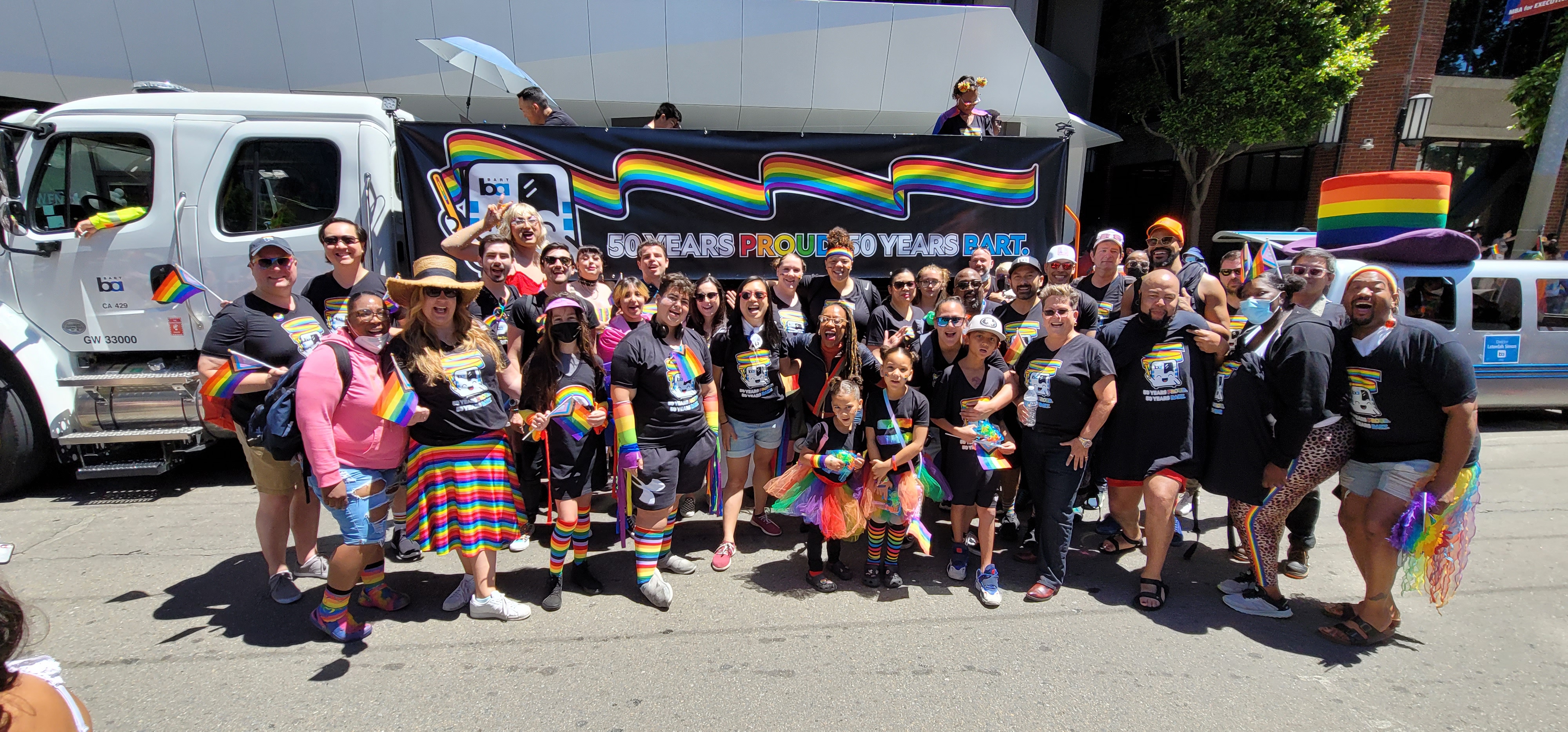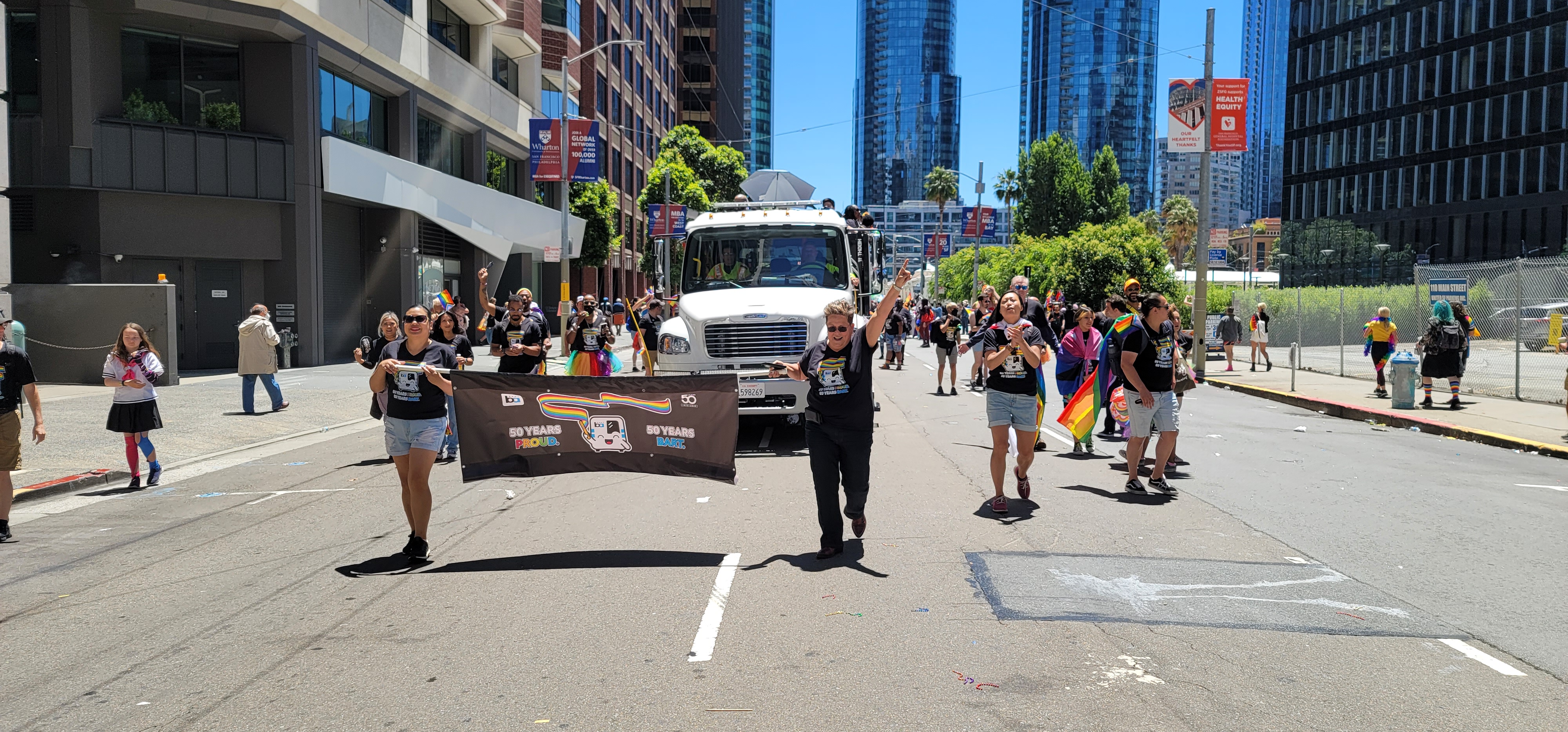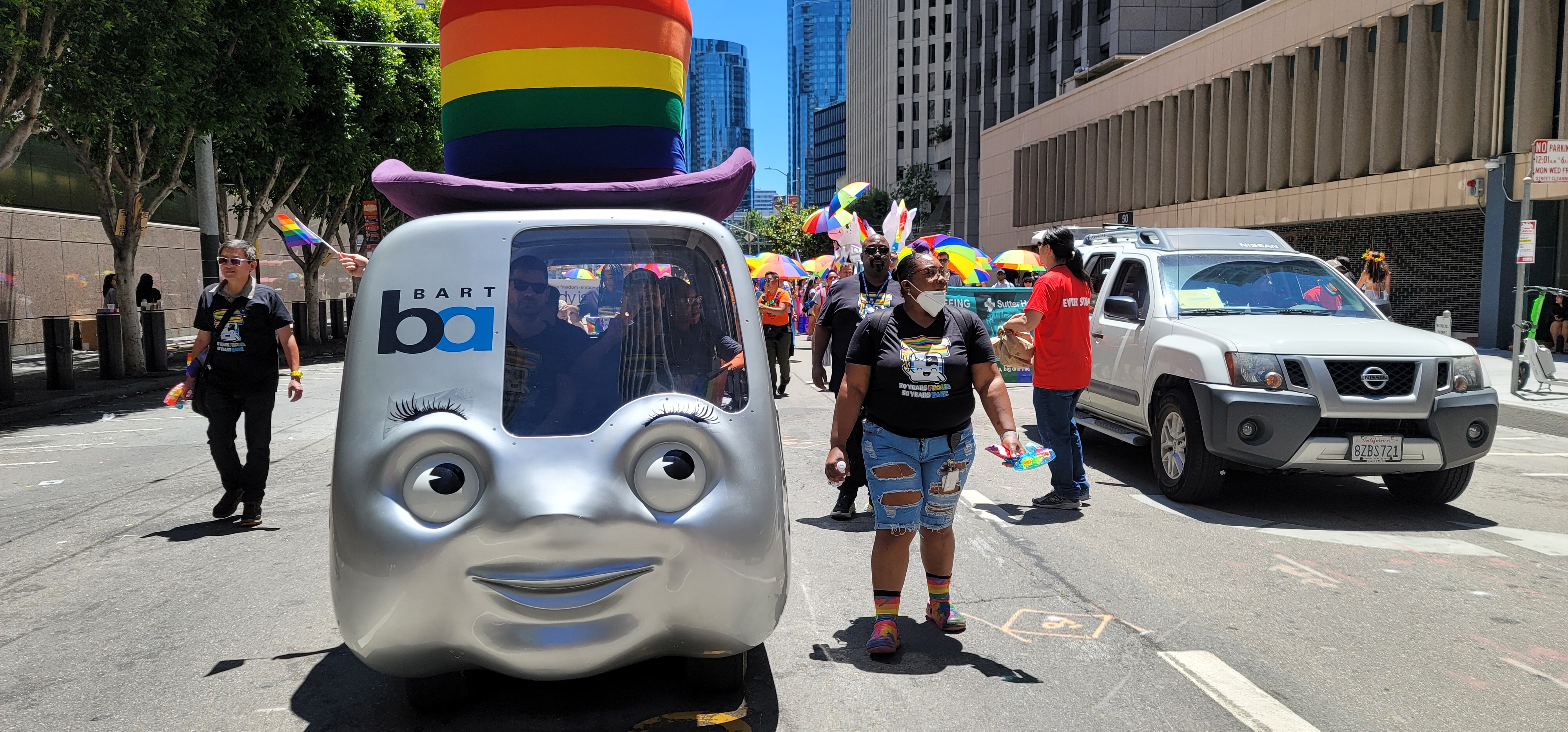Pride Month 2023: On the intersection of LGBTQ+ identity and public transit advocacy
 The BART contingent at the 2022 San Francisco Pride Parade.
The BART contingent at the 2022 San Francisco Pride Parade.
Alfred Twu recently noticed something when staring at the BART System Map.
“If you look at it, the map just so happens to be a rainbow,” quipped Twu, a transit advocate and California Democratic Party delegate.
Though we’re guessing it’s coincidental – Gilbert Baker’s rainbow flag was not flown until the 1978 San Francisco Gay Freedom Day Parade, six years after BART opened – Twu’s observation is a welcome one around BART, which has long sought to celebrate and support the diversity of communities it serves.
If you spend enough time in pro-transit spaces, you may pick up on a certain demographic trend – many of the most vocal supporters, leaders, and advocates for public transportation are also members of the LGBTQ+ community. It’s an observation that rings true even in the highest levels of governance; in 2021, US Secretary of Transportation Pete Buttigieg became the first openly gay cabinet member confirmed by the full Senate.
“Why are there connections between Community A and Community B? Much of it comes down to what you do, where you live, and how much money you have,” Twu said.
But as with most things, there is more to the tale. According to a 2020 paper by British transportation researchers, “There has been a lack of attention in mobilities literature to the role of sexuality in the usage of public transport spaces.” In the absence of data, stories and lived experiences rush in.
In celebration of Pride this year, BART Communications spoke with local transit advocates and leaders about the intersection between being LGBTQ+ and loving transit. It’s a convergence that BART has long sought to uplift, and not solely by visibly celebrating Pride with themed merchandise and a spot in the San Francisco Pride Parade each year (BART is offering its most robust service ever for the 2023 San Francisco Pride Parade).
For decades, BART has sought to create real impact and change for LGBTQ+ riders and employees. In 1994, for example, BART became only the second public transit agency in the U.S. to extend benefits to same-sex partners, thanks to a vocal contingent of employees led by Paula Fraser and Karen Goetz. In 2015, BART Police adopted a policy for interactions with trans people aimed at fostering respect and goodwill in the community. And in May, BART launched Phase II of its groundbreaking Not One More Girl campaign, a community-driven initiative centering girls and gender-expansive youth that seeks to dismantle the systems that have enabled gender-based violence and harassment. These are just some of the initiatives and policy enactments BART has pursued in recent years.
 Snapshots from the 2022 San Francisco Pride Parade.
Snapshots from the 2022 San Francisco Pride Parade.
There has long been an overlap between queerness and urbanism – and it should come as no surprise that that overlap is highly visible in the San Francisco Bay Area, which has the highest percentage of LGBTQ people of all U.S. metropolitan areas (6.7% of the total population).
“There are a lot of different theories around this,” said BART Board President Janice Li, one of three current BART Board members who identify as LGBTQ+. “A big part of it is that queer people flock to cities, which makes sense. If you grew up LGBTQ+ in a rural community, it might not be a place you’re comfortable being out, the dating pool is probably tiny, and at the end of the day, cities are more dense – there’s a greater likelihood that you’ll find a community with which you identify.”
Those living in major urban centers typically have access to more robust public transportation systems compared to rural and suburban communities. By that token, it makes sense that LGBTQ+ people would use – and therefore advocate for – public transportation.
“People who drive want to make sure their streets are paved, just like cyclists want to make sure they have bike lanes,” Twu said. “People like me who rely on transit – well, we want to make sure it’s funded.”
Those interviewed for this story agreed that yes, LGBTQ+ people love transit because they often live in cities. But each person interviewed also had a portfolio of other illuminating theories.
For BART Board member Rebecca Saltzman, “It all comes down to intersectionality.”
“When you’re part of a community that has been historically oppressed in some way, I think there’s a natural inclination to want to advocate for other causes,” she said.
LGBTQ+ people have been at the forefront of many pivotal social justice movements in the U.S. and abroad, helping to lay the groundwork for the generations of activists who followed.
“Historically, as queer people in the Bay Area, we’ve had no choice but to be politically motivated,” said transit advocate Jon Wong. “It’s great we have all these progressive policies now, but that didn’t start in a vacuum.”
Wong cited a long list of LGBTQ-led protests and movements that paved the way for future movements, from the historic Compton’s Cafeteria riot in 1966 – a response to violent and constant police harassment of trans people and drag queens – to Supervisor Harvey Milk taking his bullhorn to the streets of San Francisco.
“Queer people have been so vocal over the last few decades and that’s just continued on,” Wong said. “The difference is, now we’re able to flex our political muscle on the inside, in roles of leadership, rather than solely from the outside.”
Olive Eilbott, a transit advocate and PhD student in physics at UC Berkeley, noted that coming into oneself as a queer person is “one form of advocacy and speaking truth to power,” and that experience flames out into the rest of one’s life.
“I’ve been able to channel some of the energy from my personal life into advocating for things I think will make the entire community better,” Eilbott said.
 BART Board President Janice Li at the 2022 San Francisco Pride Parade.
BART Board President Janice Li at the 2022 San Francisco Pride Parade.
Jeffrey Tumlin, the first openly gay Director of Transportation of the SFMTA, has done quite a bit of thinking about transit advocacy and the LGBTQ+ community.
“Public transit is a really powerful tool that, by its nature, brings people together, and I think transit activism flows from that,” he said.
Tumlin drew a parallel between the act of riding transit and the act of existing in space as an LGBTQ+ person. Transit is a “little social island where we’re continually adjusting our behavior and creating new social rules,” he said. If you’re riding BART, for example, you’re likely asking yourself a series of questions you might not ask at home: Is my backpack in the way? Is my child making too much noise? Can anyone hear the music in my headphones?
“It’s on transit where we can figure out the intersection of being our true selves and being a person who might be accepted in society,” Tumlin said. “Every single bus ride is a practice run at that.”
The national poverty rate among LGBTQ+ people is higher than that of cisgender heterosexual people, and poorer people are statistically more reliant on public transportation. In the Bay Area, these issues are only compounded by the region’s severe housing crisis.
“The housing crisis is a huge issue for LGTBQ people,” Twu said. “Part of that is related to them having lower incomes. But I think the more specific issue is, if you look at the homeless population here, many are gay, trans, or queer people because they were kicked out of their homes at an age before they were self-sufficient.”
The 2022 San Francisco Youth Homeless Count and Survey found that 38% of surveyed youth identified as LGBTQ. Eighteen percent of that group identified as trans, and 10% identified as a gender “other than singularly female or male,” such as nonbinary or gender fluid.
The trans community “has always been the target of the most harrassment and violence in the LGBTQ community, especially now,” said Saltzman. She said it’s more urgent than ever that trans people “feel welcome.”
Tumlin echoed Saltzman’s comments, explaining that “one of the most crucial indicators for me about whether we’re doing right by transit is how safe trans women feel on transit and how safe children feel.”
“If we can serve these populations, we can serve everyone,” he said.
Eilbott said they’ve sometimes felt uncomfortable on public transportation as a “visibly gender-nonconforming person,” but they also try to keep in mind their privilege.
“Making space for queer people means making it work for BIPOC and disabled people, too,” they said. “It is necessarily intersectional.”
When transit agencies make their systems friendlier and more accessible to the widest swath of people possible, every person who uses the system benefits. An example of that concept in action are BART’s gender-neutral station restrooms.
“Having restrooms that are gender-neutral and open to everyone is a huge benefit for everyone who uses the system,” Twu said. “Even if you aren’t using the bathroon, you’re benefitting because then people who really need to go aren’t using the train car.”
 Snapshots from the 2022 San Francisco Pride Parade.
Snapshots from the 2022 San Francisco Pride Parade.
Alec Edges, a transit advocate and the Deputy Chair of Young Professionals in Transportation SF Bay Area, describes themself as an immigrant and queer person “who believes that a huge part of who they are is their ability to use public transportation.”
Edges said they used public transportation to get to school, to meet their partner, to travel to work, and to be with their chosen family.
“I have the option to walk outside my house, hop on BART and/or MUNI and go anywhere,” they said. “Public transit gives you that. It gives you the freedom of access, the freedom to be able to be who you are.”
Wong, too, feels the immense freedom of being able to hop on a train and go. That sense of freedom has long been attached to what he called the “heteronormativity” of suburban car culture.
“Freedom and mobility in an urban space do not come from having a car, but from having the ability to travel multimodally and connect with your community,” he said.
For Li, the“weird Venn Diagram of queer people and transit advocacy is one of joy.” In 2019, Li and transit activist Courtney Brousseau began a meetup for Bay Area LGBTQ+ people interested in public transportation. Gay for Transit started with a brief tweet exchange between Li and Brousseau and quickly blossomed into what Li described as a “fun and silly intergenerational space.” The monthly meetups were put on pause following the death of Brousseau in 2020.
“A lot of spaces around hot-button issues like public transit quickly devolve into complaints, into wishing the systems looked a certain way. They end up being very serious and cynical spaces,” Li said. “There was just something unique about Gay for Transit. It wasn’t an advocacy space or a campaign, it was just a place to come together and be queer folk who love transit.”
Li, who met her partner “through transit stuff,” understands that experiencing joy in community “touches another part of our beings.”
“We can give all the rational explanations, we can show you carbon emission statistics and traffic projections, we can constantly make the case for the importance of transit,” Li said. “But at the end of the day, what really matters is what pulls at our heart strings as humans.”
“Folks who have an irrational love and romanticization and joy when it comes to public transit – these are the stories we have to uplift, these are the people we have to engage, and these are the people who need to be the face of saving public transit,” she concluded.